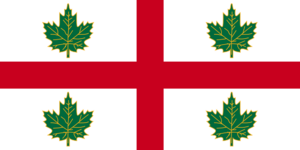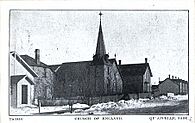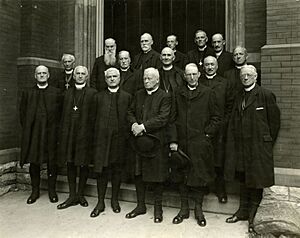Anglican Church of Canada facts for kids
Quick facts for kids Anglican Church of Canada |
|
|---|---|
| Église anglicane du Canada | |
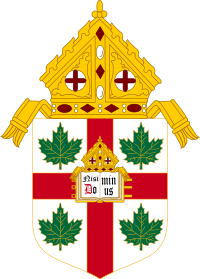
Nisi Dominus (incipit of Psalm 127)
|
|
| Abbreviation | ACC, ACoC |
| Classification | Protestant |
| Orientation | Anglican |
| Scripture | Holy Bible |
| Theology | Anglican doctrine |
| Polity | Episcopal |
| Primate | Shane Parker |
| Parishes | 1,498 |
| Associations | Anglican Communion |
| Full Communion | Church of South India Evangelical Lutheran Church in Canada Mar Thoma Syrian Church Moravian Church Northern Province |
| Region | Canada |
| Liturgy | 1962 Book of Common Prayer, Book of Alternative Services |
| Headquarters | 80 Hayden Street Toronto, Ontario, Canada |
| Branched from | Church of England |
| Separations | Anglican Church in North America (2009) Personal Ordinariate of the Chair of Saint Peter (2012) |
| Members | 294,931 on parish rolls (2022) |
The Anglican Church of Canada (ACC or ACoC) is a Christian church in Canada. It is part of the larger Anglican Communion, which includes Anglican churches around the world. In 2022, the church had about 294,931 active members in 1,498 parishes. The 2021 Canadian census showed that over 1.1 million Canadians identified as Anglican. This makes it the third-largest church in Canada.
Like other Anglican churches, the Anglican Church of Canada uses special prayer books for its services. The 1962 Book of Common Prayer is one, and the Book of Alternative Services (BAS), created in 1985, is another. The BAS is now the most commonly used prayer book.
Contents
Official Names of the Church
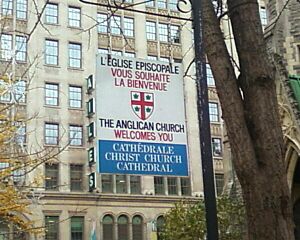
Before 1955, the Anglican Church of Canada was known as the "Church of England in Canada." In 1977, the church's main governing body, the General Synod, chose a French name: l'Église episcopale du Canada. This name was changed in 1989 to the current one, l'Église anglicane du Canada. However, you might still see the older French name used in some places.
It can be a bit confusing because the Anglican Church of Canada is a "province" of the worldwide Anglican Communion. But within Canada, the church is divided into four smaller "ecclesiastical provinces." One of these is also called the Ecclesiastical Province of Canada.
History of Anglicanism in Canada
Early Beginnings
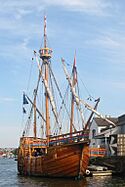
The Anglican Church of Canada remembers John Cabot's arrival in Newfoundland in 1497. The first Church of England service in Canada was held in 1578 by a chaplain on Martin Frobisher's trip to the Arctic.
The Church of England grew in Canada in a few ways. Sometimes, ship officers or government officials would read services from the Book of Common Prayer when no clergy were around. Other times, the English government or private companies would send clergy directly to settlements.
The first Church of England priest to live in Canada was Erasmus Stourton. He arrived in Ferryland, Newfoundland, in 1612. The Hudson's Bay Company also sent its first chaplain in 1683. If no chaplain was available, company officers were told to read prayers from the Book of Common Prayer on Sundays.
Organizations like the Society for the Propagation of the Gospel (SPG) were formed in England. They sent money and missionaries to help establish the English Church in Canada. They also worked to convert First Nations people. This support continued until the 1940s.
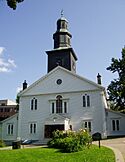
The first Anglican church in Canada was a small chapel at St. John's Fort in Newfoundland, built before 1698. The Cathedral of St. John the Baptist in St. John's is the oldest Anglican parish in Canada, started in 1699.
The oldest Anglican church building still standing in Canada is St. Paul's Church in Halifax, Nova Scotia. Its foundation stone was laid in 1750. St. Paul's became the first Anglican cathedral in North America in 1787.
After the American Revolution
After the American Revolution, many people loyal to Britain, called United Empire Loyalists, moved to Canada. Many of them were Anglicans. The Anglican Church became very important in the British colonies in North America.
One of these Loyalists was Charles Inglis. He became the first bishop of the Diocese of Nova Scotia in 1787. This made him the first Church of England bishop outside of the United Kingdom. The Anglican Church of Canada remembers Bishop Inglis on August 12.
There were strong ties between the Anglican Church in Canada and the Episcopal Church in the United States of America. Bishop Inglis helped found the University of King's College, Halifax, in 1789. It is the oldest English-speaking university in the Commonwealth outside Britain.
After the British took over Quebec and the American Revolution ended, many Anglicans wanted the Church of England to be the official church in the Canadian colonies. In some areas like Nova Scotia, New Brunswick, and Prince Edward Island, it was the official church. Bishop John Strachan of Toronto was a strong supporter of the Church of England's role. He also helped create schools, including what is now the University of Toronto.
However, other Christian groups, like the Methodists, disagreed with the Anglican Church being the official church. By the time Canadian Confederation happened in 1867, the Church of England was no longer the official church anywhere in British North America.
Becoming Independent
Until the 1830s, the Anglican church in Canada was closely tied to the Church of England in England. Bishops were chosen and priests were sent from England, and money came from the British Parliament. In the 1850s, the Canadian church started to govern itself more. The first national meeting, called the General Synod, was held in 1893. At this meeting, the church declared that it was "in full communion" with the Church of England worldwide. Robert Machray was chosen as the first leader, called the Primate.
Church Growth and Challenges
As Canada grew after 1867, so did the Anglican Church. New areas of the country got their own Anglican dioceses (church regions). Many new members came from England, Scotland, and Ireland. Because settlements were spread out and there weren't enough priests, women lay workers, called "deaconesses," played a big role in missionary work. This helped make it easier for women to become priests later on. By 2016, over 35% of Anglican clergy in Canada were women.
During this time, the Anglican Church also took on the job of running residential schools for Indigenous peoples. These schools took children away from their families. The goal was to make them adopt European culture and language. Sadly, these schools caused great harm to Indigenous children and their families.
At the same time, some Anglican missionaries also spoke up for the rights of First Nations people. For example, Henry Budd, the first First Nations priest, was ordained in 1850. The Anglican Church of Canada remembers Henry Budd on April 2.
The church also started missionary work overseas. In 1888, it began missions in Japan, which led to the creation of the Diocese of Chubu.
The Twentieth Century
In the 20th century, the Anglican Church of Canada continued to grow. It also started to focus more on social issues. In 1958, the Primate's World Relief and Development Fund was created to help people in need around the world.
In 1955, the church officially changed its name from "The Church of England in Canada" to the "Anglican Church of Canada." A new version of the Book of Common Prayer was released in 1962.
The church also started to work more closely with other Christian churches. In 1967, the Anglican Church of Canada decided to allow divorced people to remarry in their churches. In 1975, the church voted to allow women to become priests and later bishops.
However, the church also saw a big drop in the number of members. From 1961 to 2001, more than half of its members left. This decline continued into the 21st century. In 2021, the number of self-identified Anglicans in Canada was about 1 million, which was 3.1% of the Canadian population.
The Twenty-First Century
In the 21st century, some disagreements arose within the worldwide Anglican Communion, especially about social issues. This led to some groups separating from the Anglican Church of Canada.
How the Church is Organized
Anglican churches around the world share common ways of worship and beliefs. In Canada, Anglican bishops share their authority with three main groups: the General Synod, the Provincial Synods (four in Canada), and the diocesan synods (29 in total).
The national church is led by a presiding archbishop, called the Primate.
The Primate
The Primate of the Anglican Church of Canada is chosen by the General Synod from among all the bishops. The Primate is the main leader of the church in Canada. The current acting Primate is Anne Germond. She took over from Linda Nicholls, who was the first woman to lead the Anglican Church of Canada.
The General Synod
The General Synod of the Anglican Church of Canada is the main governing body of the church. It meets every three years. It includes lay people (church members who are not clergy), clergy (priests and deacons), and bishops from each of the 29 dioceses. The General Synod makes decisions about the church's beliefs, rules, and policies.
Between the General Synod meetings, a group called the Council of General Synod (COGS) manages the church's daily affairs.
Provinces, Dioceses, and Parishes
The Anglican Church of Canada is divided into four ecclesiastical provinces: British Columbia and the Yukon, Canada (which includes the Atlantic provinces and Quebec), Ontario, and Northern Lights (which covers the prairie provinces and the northern territories).
Within these provinces are 29 dioceses. Each province has its own archbishop, called the Metropolitan. Each diocese has a bishop.
Each diocese is further divided into smaller areas called parishes. In each parish, the local priest and a parish council (or vestry) help manage the church.
Working with Other Churches
The Anglican Church of Canada is a member of the World Council of Churches and the Canadian Council of Churches. It has worked with other Christian churches to build stronger relationships.
In 2001, the Anglican Church of Canada and the Evangelical Lutheran Church in Canada (ELCIC) agreed to be in "full communion." This means they recognize each other's churches and ministries. In 2023, this full communion was extended to the Northern Province of the Moravian Church in North America. The Anglican Church of Canada is also in full communion with the Mar Thoma Syrian Church and the Church of South India.
In Canadian Anglican churches, all baptized Christians are welcome to receive Holy Communion.
Worship and Prayer Books
The Anglican Church of Canada has its own versions of the Book of Common Prayer (BCP), published in 1918 and 1962. These books are based on the 1662 English prayer book. The 1962 Canadian prayer book is still used regularly and has been translated into several languages.
In 1985, the Book of Alternative Services (BAS) was released. This book uses more modern language for Anglican services. It has become very popular and is now used more often than the BCP, though the BCP is still officially recognized. Some people prefer the older BCP, while others prefer the newer BAS.
Hymns are also an important part of Anglican worship. The church has produced several authorized hymnals, with the most recent one, Common Praise, published in 1998.
Social Issues and Changes
The Anglican Church of Canada often reflects the social and cultural changes happening in Canada.
Women in Leadership
In the 1970s, the church's leader, Ted Scott, supported the idea of women becoming priests. The Anglican Church of Canada ordained its first woman as a priest in 1976. In 1993, it ordained its first woman as a bishop. This change helped women who were already serving in churches, especially in Indigenous communities, to become priests.
Residential Schools and Reconciliation
In the 19th century, the Canadian government asked the Anglican Church and other churches to run Indian residential schools. These schools caused great harm to Indigenous children.
In the 1980s, former students of these schools brought forward claims about the abuse they experienced. The church and the government worked to settle these claims. Michael Peers, who was the Primate from 1986 to 2004, played a big role in reaching a settlement. He also offered the Anglican Church's apology to Indigenous peoples for the harm caused by the residential schools.
In 2007, Mark MacDonald, an Indigenous American bishop, was appointed as the National Indigenous Bishop. He provided pastoral care to Indigenous members of the church. In 2022, Chris A. Harper became the second National Indigenous Anglican Archbishop. The church continues to work on reconciliation with Indigenous peoples.
Important Churches and Cathedrals
Cathedrals
The oldest Anglican cathedral in Canada is St. Paul's Church in Halifax. It became Canada's first cathedral in 1787. The Cathedral of the Holy Trinity in Quebec City, built from 1800 to 1804, is the oldest Anglican cathedral in Canada that is still used as a cathedral today.
Many Anglican cathedrals in Canada are modest churches. Some of the larger ones include St. James Cathedral in Toronto and All Saints' Cathedral in Halifax. All Saints' Cathedral in Halifax is Canada's largest Anglican Cathedral. It opened in 1910.
Christ Church Cathedral in Ottawa is often used for important national events, like state funerals for non-Roman Catholics. Christ Church Cathedral in Montreal is unique because it has a shopping mall and a subway station underneath it.
Notable Parishes
The Church of St. Mary Magdalene in Toronto is famous for its music. The St. Anne's Church in Toronto was known for its beautiful artwork by famous Canadian artists, but much of it was lost in a fire in 2024.
His Majesty's Royal Chapel of the Mohawks in Brantford, Ontario, and Christ Church, His Majesty's Chapel Royal of the Mohawks, near Deseronto, Ontario, are two of only three "Chapels Royal" in Canada. These chapels have a special connection to the Canadian Crown.
St. Bartholomew's Church in Ottawa has been the place of worship for Canada's Governors General since 1866.
In April 2007, St. George's Church (Georgetown, Ontario) became the first church in Canada to join the "Messy Church" program. This program focuses on community, creativity, and fun activities for families, ending with a meal.


